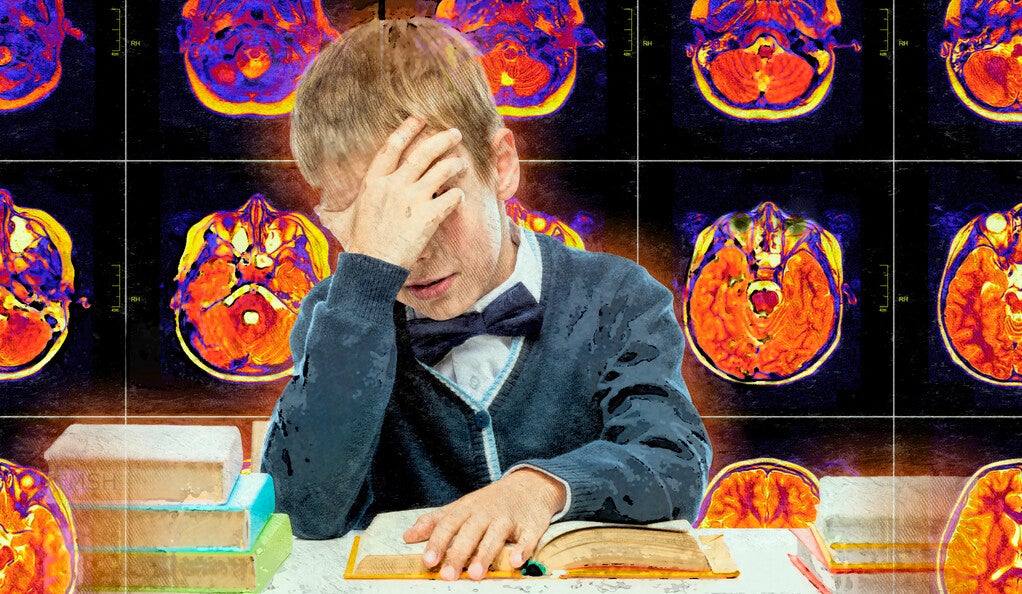Neuromarker for ADHD could improve diagnosis of the disorder

(Illustration by Michael S. Helfenbein)
For children with attention-deficit/hyperactivity disorder (ADHD), timely intervention is key. But diagnoses typically rely on questionnaires and observations of a child’s behavior, which are subjective and can lead to delays in treatment.
Yale researchers aim to establish a more objective measure of ADHD, and in a new study, they report an important step in that direction. Using brain imaging data from children with and without ADHD, they identified differences in brain structure and activity in children with ADHD that could serve as a neuromarker for the disorder.
They will present their findings Nov. 27 at the Radiological Society of North America annual meeting.
The subjectivity of ADHD assessments can cause children to be misdiagnosed or remain undiagnosed, explained Huang Lin, a research fellow at Yale School of Medicine and lead author of the study. Questionnaires given to a child’s parent or caregiver can be influenced by life events or stress, for example. The questionnaires also require caregivers to have spent a sufficient amount of time with the child, meaning children with less stable care may go undiagnosed. And as people age, they tend to show different symptoms, making diagnosis more difficult in older individuals.
“When people get older, the hyperactivity aspect of the disorder is decreased,” said Lin. “That can make it more difficult to diagnose observationally, and without a diagnosis, people with ADHD may assume that what they’re experiencing is standard.”
Lin and her colleagues used data from the Adolescent Brain Cognitive Development (ABCD) Study, which includes nearly 12,000 children from across the United States. The participants joined the study at age 9 or 10; researchers will continue tracking their biological and behavioral development into young adulthood, which will yield new data over the next few years. The demographics of the study participants mirror those of the U.S. population.
“That the study group is representative of the greater U.S. population means our findings will be generalizable to the U.S. population as well,” said Lin.
The researchers conducted a whole-brain analysis using images that measured brain structure and function in 7,805 9- to 10-year-olds. They found that the frontal cortex of the brain — an area responsible for functions like impulse control, attention, and working memory — was thinner in children with ADHD than in those without the disorder. Brain networks related to memory processing, alertness, and auditory processing were also different in children with ADHD. Further, white matter, which is composed of nerve fibers that project from one part of the brain to another, was thinner in children with ADHD. This could have implications for how different brain regions communicate with each other.
The pervasiveness of the differences was surprising, said Lin.
“I expected some brain regions to stand out. But we saw a more overall change throughout the entire brain,” she said.
The pattern the researchers uncovered was sufficiently stable across study participants that the research team used it to train a machine learning algorithm to predict who has ADHD based on brain images alone — meaning it holds promise as a diagnostic tool going forward, they said.
“The algorithm still needs further validation,” said Lin. “But once it is ready for clinical use, combining this more objective measure with the assessments already in use could allow more children to be accurately diagnosed in the future.”
The findings also emphasize that ADHD is not simply a disorder of behavior.
“Externalized behavior is certainly a part of ADHD, but there’s also a neurological correlate,” said Sam Payabvash, assistant professor of radiology and biomedical imaging at Yale School of Medicine and senior author of the study. “Better understanding of the neurological component will help with diagnosis and treatment in the future.”
It may also reduce the stigma attached to mental illness.
“If you measured someone’s blood pressure and found it was high, nobody would question that it was a condition that should be addressed. But a lot of people question diagnoses of mental illness,” said Lin. “Being able to measure it like we can blood pressure could help address that stigma.”
Media Contact
Fred Mamoun: fred.mamoun@yale.edu, 203-436-2643